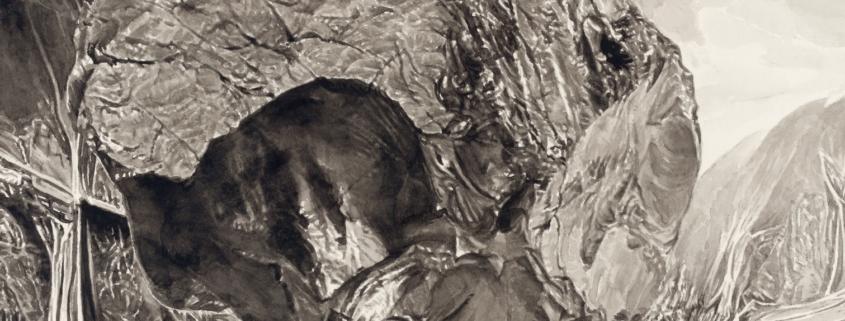
“Lamp Black refers to the pigment Stephen Ellis used to produce the works in this exhibition, its name is also used as a metaphor to illuminate contradictions in our relationship with climate change. ‘Lamp Black’ is a carbon black traditionally produced by collecting soot from oil lamps. Ellis enjoys the contradiction in its name: we think of a lamp as producing light, not something black – or can it?
Crude oil and coal – the dark icons of fossil fuels – still power our late capitalist carbon-intensive economies, despite the fact they are killing us. Yet for most of us, climate change is still a somewhat mediated experience. The artist notes that climate change is framed by mainstream media as “always unfolding”. We might think of their key climate change ‘visuals’ or stock footage: the glossy black surface of an oil spill, or the smog of urban environments and their oil-driven transport infrastructure. The blacks of coal, either glistening or light-absorbing in their powdery depths. And as temperatures rise, we might think of the black smoke of forest fires, along with their haunting, charred remains. And yet “always unfolding” is never here – and never over.
Ellis is interested in “climate contradictions”, as he calls them – the ironies and oxymorons of living with the early effects of climate change, while still maintaining our carbon-intensive lifestyles. This precarious situation requires a unique form of unsustainable denial, further compounded by the widespread practice of ‘greenwashing’. Into this smoky haze of complexity and contradiction, appearance and deception, Ellis thrusts New Zealand art history. Ellis recasts the aesthetic traditions and works of Romanticism and the Sublime in the here and now, quoting and remixing Romantic landscape heritage – both wild, remote environments and their dramatic representations – in a critical take on life in the Anthropocene. His hybrid images are convincingly rendered yet uncertain, unified yet unstable, and driven by a surreal sensibility.
Ellis’ diverse sources are montaged through an array of contemporary and traditional processes. Model making is central to his practice, borrowed and adapted from substantial professional work producing visualisations for the film and television industry. Miniaturised models, often constructed of cardboard, are placed within desktop-sized tableaux and used to make the final drawings and paintings. Ellis reveals elements of the model in the final work, even the cardboard structure’s seams held together with tape.
Images are also inserted into these three dimensional models. Ellis’ earlier work has recast the European landscapes of artists such as Caspar David Friedrich and Andreas Achenbach, and genres such as ‘shipwreck sublime’. Lamp Black features iconic paintings by Petrus van der Velden and Rita Angus, recast in Ellis’ unique world – places at once real, represented and imagined. Cass (1936) by Rita Angus is deconstructed and remade in Ellis’ desktop universe in the works Close of Day and Lamp Black. Ellis built a small scale model of the Cass railway station platform and shelter which features in Angus’ painting, and remains to this day. He also constructed a model of the railway, complete with coal trucks, which transports coal that travels through this alpine landscape from Te Tai Poutini West Coast to Otautahi Christchurch and Ohinehou, Lyttleton. Angus’ Cass is often romanticised. Indeed, in 2006 it was voted ‘New Zealand’s greatest painting’ in a public poll conducted by TV One’s arts programme Frontseat. Ellis’ representation reveals another side of this region, indelibly linked to fossil fuels.
Similarly, sections of two works by Dutch immigrant Petrus van der Velden, Mt Rolleston and the Otira River (1893) and Otira Gorge (1912), are quoted in Ellis’ works Close of Day and Lamp Black. Ellis’ works contain fragments of van der Velden’s landscapes alongside the Otira Tunnel through which the coal passes on its rail journey. Here, van der Velden’s brooding, stormy landscapes can also be read as signalling the dark skies of contemporary storm systems, becoming more frequent and intense as a result of climate change.
The Romantic Sublime sought delight in the ‘awe and terror’ of encounters with wild, untamed environments and being dwarfed by nature. Ellis notes that it was a largely middle-class movement for those with the means to travel, and whose popular destinations included large ancient forests, alps and the sites of avalanches. In contrast, a contemporary sublime offers a potential lens or framework through which to view and attempt to understand the scale and accelerating pace of climate change. The wider environmental impacts of the Anthropocene will be felt by all, yet unevenly distributed. Ellis notes that the frisson of terror was a prerequisite of the Romantic Sublime, as defined by Anglo-Irish philosopher Edmund Burke, and is now perhaps superseded by genuine terror.
Ellis grew up in Otepoti Dunedin and Otautahi Christchurch in the 1960-70s with the smell of bituminous coal burning in the fireplace, and in the air. The nostalgia that coal now occupies for him is also a source of irony. In a suite of new works; coal is highly aestheticized, and rendered in exquisite detail. Glacier Country I – III (2023) feature giant lumps of coal levitating over glacial South Island landscapes. The artist refers to as ‘coal portraits’ and they originate in studies made from individual pieces of coal. Their defiance of gravity and monumental scale encodes them with a kind of magic power or supernatural presence. Ellis describes them as “talismanic”.
Aotearoa’s only deposit of anthracite, the highest quality coal, is buried under Te Moeka o Tuawe Fox Glacier and Potikohua Fox River, one of our premium ‘untouched’ tourist destinations. The artist notes that the ‘100% Pure New Zealand’ tourism promotion is still being advertised domestically in Aotearoa, while few New Zealanders would still support the view that our environmental actions can be reconciled with the image we tell and sell ourselves.
In this exhibition Ellis invites viewers to examine their own attitudes to our landscape and climate. Are they clouded by romance and fictions? For the artist, a clear-eyed view of our attitudes to a place we love – its past and future – is healthy, illuminating and a potential source of hope.” – Emil McAvoy, July 2023.
Opening Event: Saturday 12 August, 11am- 1pm.
Follow this artist
Sign up to receive the latest updates on this artist including exhibitions, VIP previews, landmark events, news and milestones.




